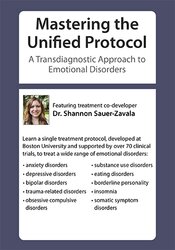Avoiding the “What Do I Treat First?” Trap
Treating emotional disorders more effectively with the Unified Protocol

What if we could lean into one treatment approach to respond to a wide variety of clinical issues…one therapy that could cut to the heart of what creates suffering?
Hear from Dr. Shannon Sauer-Zavala, co-developer of the Unified Protocol and founding director of the Unified Protocol Institute at Boston University, on what makes the Unified Protocol, an evidence-based and transdiagnostic treatment for emotional disorders, so effective.
What can you tell us about why the Unified Protocol was developed?
There are two main reasons why the Unified Protocol was developed.
The first follows cutting-edge science in understanding the development and maintenance of emotional disorders. Researchers at our clinic started to notice that there were high rates of comorbidity amongst common presenting problems. It was rare for a patient to come in with just one diagnosis.
Typically, if someone had panic disorder, they also had social anxiety disorder, generalized anxiety disorder, or depression as well. This comorbidity was the rule, not the exception.
The science points to core underlying processes that put a person at risk for a range of different disorders, and the idea with the Unified Protocol is that if you could address these core underlying difficulties instead of playing whack-a-mole at the symptom level, you’ll have a more efficient approach to care.
Neuroticism, the tendency to experience emotions strongly along with not liking your emotions, is at the heart of these disorders. Common thoughts include it’s weak to feel this way, I know no one else is reacting like this, and I shouldn’t be feeling this way. This is at the root of a whole range of presentations: anxiety disorders, obsessive compulsive and related disorders, mood disorders, depressive disorders, and more.
If we follow the science, we see that these aversive avoidant reactions to frequently occurring negative emotions are what's driving a lot of the symptoms.
The second reason is on the treatment development side. There are countless different manualized treatments for every disorder in the DSM, and it puts therapists in a tough position. If you want to be providing evidence-based care in the way that it was developed in our clinical trials, you’d have to have a different manual for nearly every client that walks in.
If you have a client that’s coming in with more than one disorder, it becomes tough when you consider that most of our gold standard treatment manuals are focused on one disorder. If our manuals aren’t mapping onto what you see in real life, that’s going to make it hard to utilize them.
The Unified Protocol was created as a transdiagnostic treatment that targets the underlying mechanism instead of the symptoms, and that makes it applicable to a wide range of patients. For most outpatient practitioners, this protocol is going to work well for most patients. And if you’re using this protocol with most of your patients, you’re going to get really good at providing it.
What can you tell us about how clients tend to engage with the Unified Protocol? Some therapists have concerns about protocols feeling overly mechanical.
The Unified Protocol contains skills that most practitioners with CBT experience are using to some degree anyway, like mindfulness, psychoeducation, cognitive flexibility, behavior change, and exposure. These are great skills to have in your toolkit, and the Unified Protocol is not necessarily prescriptive around how you present them.
There’s a lot of flexibility for the therapist to make this protocol their own and tailor it to the presentation of the client. That’s going to be necessary in a transdiagnostic treatment.
A lot of times, patients come in and want skills. They want to know what to do about how they’re feeling. Where the Unified Protocol is particularly strong is it provides skills without being overly rigid. It provides a solid set of evidence-based skills, but there’s still room for the therapeutic relationship that we know is so important.
One of the cool things about the Unified Protocol is that instead of targeting the symptoms of any one disorder, we’re going to target shared processes like worry. What we're teaching patients to do across all these common CBT skills is develop a more accepting and approach-oriented stance towards their emotions.
One of the things we do early on in treatment with the Unified Protocol is help establish for patients the rationale. They experience their emotions strongly and have developed a set of negative beliefs around them. That’s led them to engage in strategies that push those emotions away. It’s the job of the therapist to help the patient understand that those short-term strategies aren’t working.
With the Unified Protocol, we’re focusing on the experience of emotions broadly. This includes learning to notice our emotions, thank ourselves for having them, and recognize what they’re telling us. We evolved to have emotions – they’re adaptive. So rather than engage in knee-jerk strategies to push them away, we help clients engage in long-term strategies that might require them to feel those emotions a little bit more, but also set them up for success going forward.
And these skills are transferable. If a client starts to become anxious in a new setting after a course of treatment, they have the skills to deal with this emotion. For example, a client might realize:
- I’m feeling anxious, and I know I’m not supposed to push that away, because it’s telling me something important. In my new job, I have to give presentations in meetings, and I didn’t have to do that before. These strong emotions are telling me that this work meeting is important to me. I can’t avoid these emotions, so I have to keep doing this until I learn that bad outcomes aren’t going to happen and that the emotions won’t last forever.
Could you give us a preview of one skill that gets taught in the Unified Protocol?
I’ll talk a little bit about mindfulness.
In the Unified Protocol, our first mindfulness session involves some meditation practice and a formal guided meditation. We tell patients that this is their opportunity to get their feet wet with mindfulness and see what it feels like to apply a present-focused non-judgmental stance towards emotions in the context of a neutral mood. We ask patients to practice doing this for a week.
In our second session on mindfulness, we teach some skills for how to apply that present-focused non-judgmental attention to real-life stressors. This is where we bring in two additional skills.
The first is called the mindful mood induction. We have patients choose a personally relevant song that is likely to bring up strong emotions for them, and we practice the principles of present focus and non-judgmental attention in the context of a difficult mood.
Finally, we talk about the real-world application, which is utilizing this skill any time a patient notices an emotion starting to build for them. When that happens, we ask them to anchor themselves in the present using a physical cue, such as their breath or the sensation of the feet on the floor.
Then we ask them to do a three-point check:
- What did I just tell myself?
- What am I doing right now?/What do I feel like doing?
- What am I feeling in my body?
The patient takes this time out, takes stock of what’s going on, and then asks themselves if what’s happening right now is driven by concerns about the past or future. If it is, can they bring the response they’re having back in line with the demands of the present moment?
Patients tend to like this approach. It gives them the opportunity to practice mindfulness in a way that’s concrete and tangible.

In this workshop, Dr. Shannon Sauer-Zavala, co-developer of the UP, will walk you through 8 easy-to-learn modules and demonstrate how you can use UP principles flexibly to:
- Harness your clients’ motivation toward change
- Teach your clients to better understand and utilize the power of their emotions
- Facilitate cognitive restructuring exercises to enhance the clarity of your clients’ thinking and deciding
- Revamp your clients’ mistaken appraisals of triggering body sensations
- Improve your clients’ ability to be present and in charge of their behaviors
Rooted in the power of emotion-focused CBT and shown to be effective in over 70 rigorous clinical trials, the Unified Protocol lets you get to the core of mental health issues and focus on your client - not labels.
Learn more about their educational products, including upcoming live seminars, by clicking here.
Topic: Anxiety/Depression | Cognitive Behavioral Therapy (CBT) | Unified Protocol (UP)
Tags: Anxiety | Depression | Mindfulness | Strategies | Success | Tools | Video





